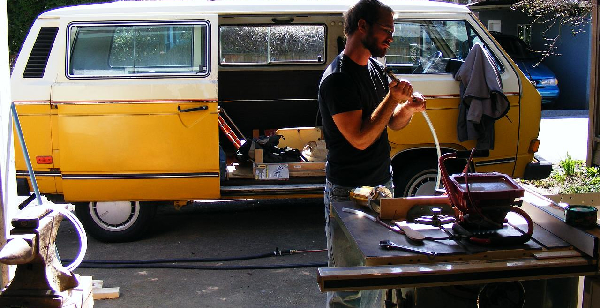How to Stop Paying for Gas and Run on Free Vegetable Oil in 8 Easy Steps
Brad Whipple, Guest
Waking Times
WOULDN’T IT BE GREAT to pack-up the car or the SUV for a weekend excursion without fretting over the cost of fuel? Or take that road trip you and your friends keep talking about? All with no concern about pumping all of your hard-earned cash into the gas tank. Heck, it would be great just to drive around town without that concern. Here’s how you can do it.

Image Source
1. Commitment
This will not happen overnight. Nor will it work if you just want something for nothing. There are some up-front costs, but more importantly, it’s the dedication of your time and energy that puts the money back in your pocket. You’re going to give up the quick convenience of the express station, so you have to truly believe in the value of what you’re doing. But once you make this determination, the hardest part is already done.
2. The technology
The technology has existed for almost 100 years. Rudolf Diesel designed his engine to run on corn oil that he had collected on his Iowa farm. He wanted a more efficient way to run his farm machinery because gasoline had reached a staggering $0.05 per gallon! Look it up yourself – the diesel engine was intentionally designed to operate on vegetable oil, not toxic petroleum byproducts. And that’s all you’re going to do.
3. Sourcing your vegetable oil.
Every restaurant and probably most bars in your community are currently paying somebody else to come and haul away their waste vegetable oil from the fry-o-laters.
In your local supermarket, vegetable oil retails for about $10/gallon, almost three times as expensive as regular unleaded gasoline these days. You want free vegetable oil. Well, every restaurant and probably most bars in your community are currently paying somebody else to come and haul away their waste vegetable oil from the fry-o-laters.
That’s your source. Develop a relationship with the manager or owner of local establishments. Tell him or her that you’re interested in collecting their waste vegetable oil. Offer to do it for free.
Make sure they use NON-HYDROGENATED oil. You do not want that creamy based oil. You may have to supply them with a collection barrel, and you want to make sure the manager can depend on you to collect at regular intervals so he doesn’t have to worry about it.
4. Processing the oil.
The oil that you collect is not ready to burn. It must be heated and filtered. You will need a couple of barrels’ worth of space in a garage or basement where you can set-up your little processing station. If you don’t have the space, consider getting a co-op going with friends or other people in your community who do.
In any case, the system is not complicated, it just requires a little bit of money to set-up and then a regular bit of attention to generate usable oil. There are many different methods for this process, but they all essentially involve heating the oil in one tank, then pumping it through some filtration device to a second tank.
The whole point is to remove any water and particles that have collected in the oil during use. Lots of people have posted their processing plants on YouTube or other veggie forums such as Fryer to Fuel. There is not ONE way to do it, and you will have to devise the best way for you to do it with regard to your space, time, and budget.
5. Lining up your vehicle.
Now you need the vehicle to utilize all of this wonderful, free oil. Hopefully you aren’t terribly attached to whatever it is that you’re driving now. The decision to run on veggie oil limits the type of vehicle you can drive because only certain models are produced with a diesel engine.
Maybe you’ll decide that, since you’re going to be driving for free anyway, you might as well drive the biggest, baddest rig you can find.
 The good news is that these models are quite nice. Volkswagen has offered diesel versions of the Golf and the Jetta for years, and the list now includes the Passat. And Mercedes has several sedan models and even a wagon with the available diesel. And fortunately for the checkbook, you don’t want a new one anyway. The older models make better conversion candidates because the engine is less complicated. A little bit of research (check greasecar)will turn-up a car you like that fits your budget.
The good news is that these models are quite nice. Volkswagen has offered diesel versions of the Golf and the Jetta for years, and the list now includes the Passat. And Mercedes has several sedan models and even a wagon with the available diesel. And fortunately for the checkbook, you don’t want a new one anyway. The older models make better conversion candidates because the engine is less complicated. A little bit of research (check greasecar)will turn-up a car you like that fits your budget.
Maybe you’ll decide that, since you’re going to be driving for free anyway, you might as well drive the biggest, baddest rig you can find. The Big 3 American auto manufacturers produce diesel powered trucks and SUVs that also make excellent conversion candidates. Again, the slightly older models offer a little more ease of conversion. The bottom line is, you should be able to find a ride that makes you happy.
6. Conversion
Now you have to tweak the fuel system to accommodate your veggie oil. The major issue is temperature. There are all kinds of conversion kits for sale from different companies on the internet. They can cost as much as $4000.00. And they all insist that if you can read instructions you can install the kit yourself.
Or you can go to one of their authorized installers and drop another G for them to do it for you. The money saves you the hassle of doing it yourself and buys you peace of mind and presumably customer service, should a problem arise.
The truth is that most of these kits are just a compilation of parts and pieces – hoses, gauges, valves – that you can buy cheaper from a direct source. And if you or someone you know has any degree of comfort around an engine, then yes, you can convert your car yourself. Just research. Again, there are lots of community forums about converting to veggie oil, and even a bunch of videos on uTube. It’s the commitment issue again. Understanding how the process works will give you the ability to address it.
7. Notes on cost
Nothing is truly free. Assuming that you trade your current vehicle for one of equal value, the start-up cost for your alternative fuel program, including your processing plant and the conversion, will likely top $3000.00 even if you do it all yourself.
Again, a co-op is a good idea: you can gather people you trust to help curb the initial cost of the plant and to share collection duties and split time actually processing the oil.
If you spend $50/week on fuel, it will take one year and two months for your program to pay for itself. And of course there’s your time to collect and process the oil, plus the bit of energy needed to operate the plant. Be sure to find out if your state has an alternative fuel road tax provision on the books too, so you can jump that hurdle.
And thereafter you’re driving for free! And in the meantime that’s 50 bucks each week to take your girl out to dinner or contribute to your IRA or whatever. Plus it’s better for the environment, recycling oil and no carbon emissions. And when you want to take that trip, the WVO Network, a nationwide community of veg-heads, will propel you around the country.
8. Drive!
This might all seem like too big a deal. Well, putting several thousand dollars a year back in your pocket is a big deal. Forgetting the major cost of road travel is a big deal. Conserving resources and protecting the environment is a big deal.
Converting to veg allows you to contribute to softening a global crisis and improves your personal bottom line significantly over the long term. The first time you flip that switch and you’re running on straight veg, the headaches and expense of converting blow right out the tailpipe!
~~ Help Waking Times to raise the vibration by sharing this article with the buttons below…
